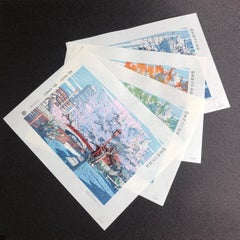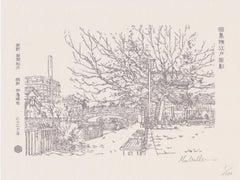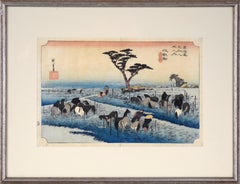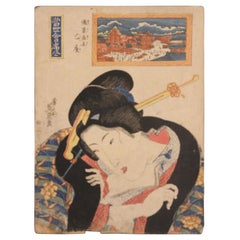UKIYO-E PROJECT Landscape Prints
to
8
Overall Width
to
Overall Height
to
8
6
2
5
4
2
2
2
2
1
1
1
1
1
1
1
1
8
Vestiges of Edo in Tsukuda - Set of Four Seasons
Located in Koto-Ku, 13
About Vestiges of Edo in Tsukuda (Tsukuda ni Nokoru Edo no Omokage)
Artist: URBANOWICZ Mateusz
Woodcarver: SEKIOKA Senrei III
Printer: ITO Tatsuya
Year: 2020
Our first original landscape ukiyo-e depicting Tsukuda, a neighborhood next to Tsukishima station in the east of Tokyo. This artwork highlights the striking contrast between the modern architecture and historical elements, that co-exist in harmony in Tsukuda today. The Japanese title Tsukuda ni Nokoru Edo no Omokage translates to “the vestiges of Edo in Tsukuda” - the word omokage (vestige) refers to the river, an aspect of old Edo that has continued to exist to this day, despite the fact that other things may have evolved or disappeared with time.
When we trace back the history of ukiyo-e, we can see that there have been many foreign ukiyo-e artists who created important shin-hanga works in the 20th century, such as Paul Jacoulet, Elizabeth Keith...
Category
2010s Edo Landscape Prints
Materials
Woodcut
Vestiges of Edo in Tsukuda - Outline
Located in Koto-Ku, 13
About Vestiges of Edo in Tsukuda (Tsukuda ni Nokoru Edo no Omokage)
Artist: URBANOWICZ Mateusz
Woodcarver: SEKIOKA Senrei III
Printer: ITO Tatsuya
Year: 2020
Our first original landscape ukiyo-e depicting Tsukuda, a neighborhood next to Tsukishima station in the east of Tokyo. This artwork highlights the striking contrast between the modern architecture and historical elements, that co-exist in harmony in Tsukuda today. The Japanese title Tsukuda ni Nokoru Edo no Omokage translates to “the vestiges of Edo in Tsukuda” - the word omokage (vestige) refers to the river, an aspect of old Edo that has continued to exist to this day, despite the fact that other things may have evolved or disappeared with time.
When we trace back the history of ukiyo-e, we can see that there have been many foreign ukiyo-e artists who created important shin-hanga works in the 20th century, such as Paul Jacoulet, Elizabeth Keith...
Category
2010s Edo Landscape Prints
Materials
Woodcut
Vestiges of Edo in Tsukuda - Winter
Located in Koto-Ku, 13
About Vestiges of Edo in Tsukuda (Tsukuda ni Nokoru Edo no Omokage)
Artist: URBANOWICZ Mateusz
Woodcarver: SEKIOKA Senrei III
Printer: ITO Tatsuya
Year: 2020
Our first original landscape ukiyo-e depicting Tsukuda, a neighborhood next to Tsukishima station in the east of Tokyo. This artwork highlights the striking contrast between the modern architecture and historical elements, that co-exist in harmony in Tsukuda today. The Japanese title Tsukuda ni Nokoru Edo no Omokage translates to “the vestiges of Edo in Tsukuda” - the word omokage (vestige) refers to the river, an aspect of old Edo that has continued to exist to this day, despite the fact that other things may have evolved or disappeared with time.
When we trace back the history of ukiyo-e, we can see that there have been many foreign ukiyo-e artists who created important shin-hanga works in the 20th century, such as Paul Jacoulet, Elizabeth Keith...
Category
2010s Edo Landscape Prints
Materials
Woodcut
Vestiges of Edo in Tsukuda - Autumn
Located in Koto-Ku, 13
About Vestiges of Edo in Tsukuda (Tsukuda ni Nokoru Edo no Omokage)
Artist: URBANOWICZ Mateusz
Woodcarver: SEKIOKA Senrei III
Printer: ITO Tatsuya
Year: 2020
Our first original landscape ukiyo-e depicting Tsukuda, a neighborhood next to Tsukishima station in the east of Tokyo. This artwork highlights the striking contrast between the modern architecture and historical elements, that co-exist in harmony in Tsukuda today. The Japanese title Tsukuda ni Nokoru Edo no Omokage translates to “the vestiges of Edo in Tsukuda” - the word omokage (vestige) refers to the river, an aspect of old Edo that has continued to exist to this day, despite the fact that other things may have evolved or disappeared with time.
When we trace back the history of ukiyo-e, we can see that there have been many foreign ukiyo-e artists who created important shin-hanga works in the 20th century, such as Paul Jacoulet, Elizabeth Keith...
Category
2010s Edo Landscape Prints
Materials
Woodcut
Vestiges of Edo in Tsukuda - Summer
Located in Koto-Ku, 13
About Vestiges of Edo in Tsukuda (Tsukuda ni Nokoru Edo no Omokage)
Artist: URBANOWICZ Mateusz
Woodcarver: SEKIOKA Senrei III
Printer: ITO Tatsuya
Year: 2020
Our first original landscape ukiyo-e depicting Tsukuda, a neighborhood next to Tsukishima station in the east of Tokyo. This artwork highlights the striking contrast between the modern architecture and historical elements, that co-exist in harmony in Tsukuda today. The Japanese title Tsukuda ni Nokoru Edo no Omokage translates to “the vestiges of Edo in Tsukuda” - the word omokage (vestige) refers to the river, an aspect of old Edo that has continued to exist to this day, despite the fact that other things may have evolved or disappeared with time.
When we trace back the history of ukiyo-e, we can see that there have been many foreign ukiyo-e artists who created important shin-hanga works in the 20th century, such as Paul Jacoulet, Elizabeth Keith...
Category
2010s Edo Landscape Prints
Materials
Woodcut
Vestiges of Edo in Tsukuda - Spring
Located in Koto-Ku, 13
About Vestiges of Edo in Tsukuda (Tsukuda ni Nokoru Edo no Omokage)
Artist: URBANOWICZ Mateusz
Woodcarver: SEKIOKA Senrei III
Printer: ITO Tatsuya
Year: 2020
Our first original landscape ukiyo-e depicting Tsukuda, a neighborhood next to Tsukishima station in the east of Tokyo. This artwork highlights the striking contrast between the modern architecture and historical elements, that co-exist in harmony in Tsukuda today. The Japanese title Tsukuda ni Nokoru Edo no Omokage translates to “the vestiges of Edo in Tsukuda” - the word omokage (vestige) refers to the river, an aspect of old Edo that has continued to exist to this day, despite the fact that other things may have evolved or disappeared with time.
When we trace back the history of ukiyo-e, we can see that there have been many foreign ukiyo-e artists who created important shin-hanga works in the 20th century, such as Paul Jacoulet, Elizabeth Keith...
Category
2010s Edo Landscape Prints
Materials
Woodcut
Vestiges of Edo at Bell Tower - Evening
Located in Koto-Ku, 13
About Vestiges of Edo at Bell Tower (Toki no Kane Edo no Omokage)
Artist: URBANOWICZ Mateusz
Woodcarver: SEKIOKA Senrei III
Printer: ITO Tatsuya
Year: 2021
A former castle town situ...
Category
2010s Edo Landscape Prints
Materials
Woodcut
Vestiges of Edo at Bell Tower - Noon
Located in Koto-Ku, 13
About Vestiges of Edo at Bell Tower (Toki no Kane Edo no Omokage)
Artist: URBANOWICZ Mateusz
Woodcarver: SEKIOKA Senrei III
Printer: ITO Tatsuya
Year: 2021
A former castle town situ...
Category
2010s Edo Landscape Prints
Materials
Woodcut
Related Items
"Early Summer Horse Fair" from 53 Stations of the Tokaido
By Utagawa Hiroshige (Ando Hiroshige)
Located in Soquel, CA
"Early Summer Horse Fair" from 53 Stations of the Tokaido
Woodblock print of a group of horses, originally by Hiroshige (Ando) Utagawa (Japanese, 1797 - 1858). Several groups of hor...
Category
1830s Edo Figurative Prints
Materials
Rice Paper, Woodcut
Biensennyo-ko Japanese Woodblock Print
By Keisai Eisen
Located in Houston, TX
Japanese Woodblock print of a Biensennyo-ko a powder face women. Behind the women is a framed cityscape. The print is possibly from the series "Eight Favorite Things in the Modern World". The woodblock print is printed on rice paper. The print is not framed.
Artist Biography: Keisai Eisen...
Category
Early 1800s Edo Portrait Prints
Materials
Woodcut
Two Actors - Japanese Woodblock by Chikanobu Yoshu
By Toyohara Chikanobu
Located in Soquel, CA
Two Actors - Japanese Woodblock by Toyohara Chikanobu (豊原周延, 1838–1912), better known to his contemporaries as Yōshū Chikanobu (楊洲周延).
Colorful and expressive court scene. Two actors...
Category
1890s Edo Landscape Prints
Materials
Ink, Rice Paper, Woodcut
H 18.5 in W 13.5 in D 1 in
Edo Landscape Japanese Woodblock Print
By Utagawa Hiroshige (Ando Hiroshige)
Located in Houston, TX
Edo Meisho woodblock print of a famous Japanese coastal dock. This woodblock is most likely apart of the series "One Hundred Famous Views of Edo." The woodblock print is printed on r...
Category
1850s Edo Landscape Prints
Materials
Woodcut
H 10 in W 15 in D 0.004 in
The Moon Crossing Bridge at Arashiyama in Yamashiro Province, Original Woodblock
By Utagawa Hiroshige
Located in Saint Augustine, FL
Artist: Utagawa Hiroshige (1797-1858) Japanese
Title: The Moon Crossing Bridge at Arashiyama in Yamashiro Province
Medium: Original Woodblock Print
Year: 1853 - 1856
Dimensions: Framed 16" x 23", Unframed 8.5" x 13"
Hiroshige Utagawa grew up in a samurai family in Edo where both him and his father were in the fire service before being orphaned. Hiroshige’s first formal art teacher was Rinsai. Though Hiroshige tried to join Toyokuni Utagawa's studio, he was turned away. In 1811, young Hiroshige entered an apprenticeship with the celebrated Toyohiro Utagawa. After only a year, he was bestowed with the artist name Hiroshige. He gave up his role in the fire department to focus entirely on painting and print design. He studied painting, intrigued by the Shijo school. Hiroshige’s artistic genius wasn’t recognized until 1832 when he became a master of the ukiyo-e woodblock printing tradition, creating 8000 prints in saturated color.
His series of woodblock prints of the Tokaido road connecting Edo to Kyoto was his breakthrough series known as The 53 Stations of the Tokaido (1832-1833). His most renowned series was known as 100 Famous Views of Edo...
Category
Mid-19th Century Edo Landscape Prints
Materials
Woodcut
Mitate of a Daimyo's Procession Crossing Ryogoku Bridge - Woodblock Print
By Keisai Eisen
Located in Soquel, CA
Mitate of a Daimyo's Procession Crossing Ryogoku Bridge - Woodblock Print
Woodblock print of a procession by Keisai Eisen (Japanese, 1790–1848). Terrific triptych of a procession of...
Category
Early 19th Century Edo Figurative Prints
Materials
Ink, Rice Paper, Woodcut
H 24 in W 36 in D 0.25 in
Courtiers under a wisteria draped pine tree
Located in Middletown, NY
Tokyo: Yokoyama Ryohachi, 1892
Woodcut in ink with embossing and hand-coloring in watercolor on handmade mulberry paper, 14 1/2 x 9 7/8 inches (368 x 251 mm), ōban tate-e, the full ...
Category
Late 19th Century Edo Portrait Prints
Materials
Watercolor, Handmade Paper, Woodcut
Study of Utagawa Hiroshige's "View of Hara-Juku" 53 Stations of the Tokaido Road
By Utagawa Hiroshige
Located in Soquel, CA
Study of Utagawa Hiroshige's "View of Hara-Juku" 53 Stations of the Tokaido Road
Hand painted study of Utagawa Hiroshige's "View of Hara-Juku", (by unknown artist), from "53 Station...
Category
1920s Edo Landscape Prints
Materials
Paper, Ink, Woodcut
H 11 in W 14 in D 0.25 in
Beauties on the Beach with view of Mount Fuji
By Yoshu Chikanobu
Located in Burbank, CA
Shichirigahama, Sagami Province. A beauty in the foreground waves to her young companions, who run towards her on the beach. The beauty at left wears a western-style golden ring. We ...
Category
1890s Edo Landscape Prints
Materials
Handmade Paper, Mulberry Paper, Woodcut
Kiyomizu Temple, Scenes of Famous Places along Tôkaidô Road - Woodblock on Paper
By Utagawa Hiroshige II
Located in Soquel, CA
Kiyomizu Temple, Scenes of Famous Places along Tôkaidô Road - Woodblock on Paper
Full Title:
Kyoto: Kiyomizu Temple (Kyô Kiyomizudera), from the series Scenes of Famous Places along...
Category
1860s Edo Landscape Prints
Materials
Ink, Rice Paper, Woodcut
Sumiyoshi: Dengaku dance performed during an Onda ceremony - Woodblock Print
By Utagawa Hiroshige
Located in Soquel, CA
Sumiyoshi: Dengaku dance performed during an Onda ceremony - Woodblock Print
Bright woodblock print by Utagawa Hiroshige (Japanese, 1797-1858). In this scene, two dancers with swords and fans are facing each other, in the center of a courtyard. There are spectators surrounding them, including nobles in black clothing on a balcony.
Presented in a new off-white mat with foamcore backing.
Mat size: 16"H x 20"W
Paper size: 9.63"H x 14.5W"
Utagawa Hiroshige (1797-1858, sometimes called Ando Hiroshige) was the second of the two great masters of the Japanese landscape woodblock print...
Category
1830s Edo Figurative Prints
Materials
Ink, Rice Paper, Woodcut
(創作版画 Mid-Century Japanese Coloured Woodblock Print. Ploughing the Fields.
Located in Cotignac, FR
Mid-Century coloured woodblock print of 'ploughing the fields' by 20th century Japanese artist Ini Kumo. The print is hand-signed in pencil, dated 1966 and numbered 130/700 to the bottom right and presented under glass in a black wooden frame.
A beautiful woodblock printed image of a Japanese farmer in traditional attire ploughing the land with his ox. It is early evening and as the sun goes down it casts long shadows in front of the two figures. Perhaps the farmer is on his way back to the houses grouped in the distance already in shadow. The artist has carefully picked out areas of vibrant green and blue to give energy and colour to the image which contrast against the black of the ox.
A thoroughly enchanting image.
Ini Kumo is a recognised Sõsaku-hanga artist. His work is included in the Metropolitan Museum of Art in New York.
Sōsaku-hanga (創作版画, "creative prints") was an art movement of woodblock printing which was conceived in early 20th-century Japan. It stressed the artist as the sole creator motivated by a desire for self-expression, and advocated principles of art that is "self-drawn" (自画 jiga), "self-carved" (自刻 jikoku) and "self-printed" (自摺 jizuri). As opposed to the parallel shin-hanga ("new prints") movement that maintained the traditional ukiyo-e collaborative system where the artist, carver, printer, and publisher engaged in division of labor.
The birth of the sōsaku-hanga movement was signaled by Kanae Yamamoto...
Category
Mid-20th Century Edo Landscape Prints
Materials
Ink, Paper
H 16.93 in W 20.28 in D 0.4 in







